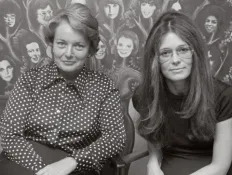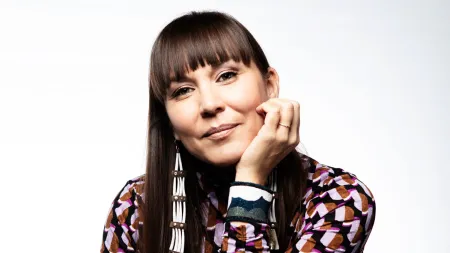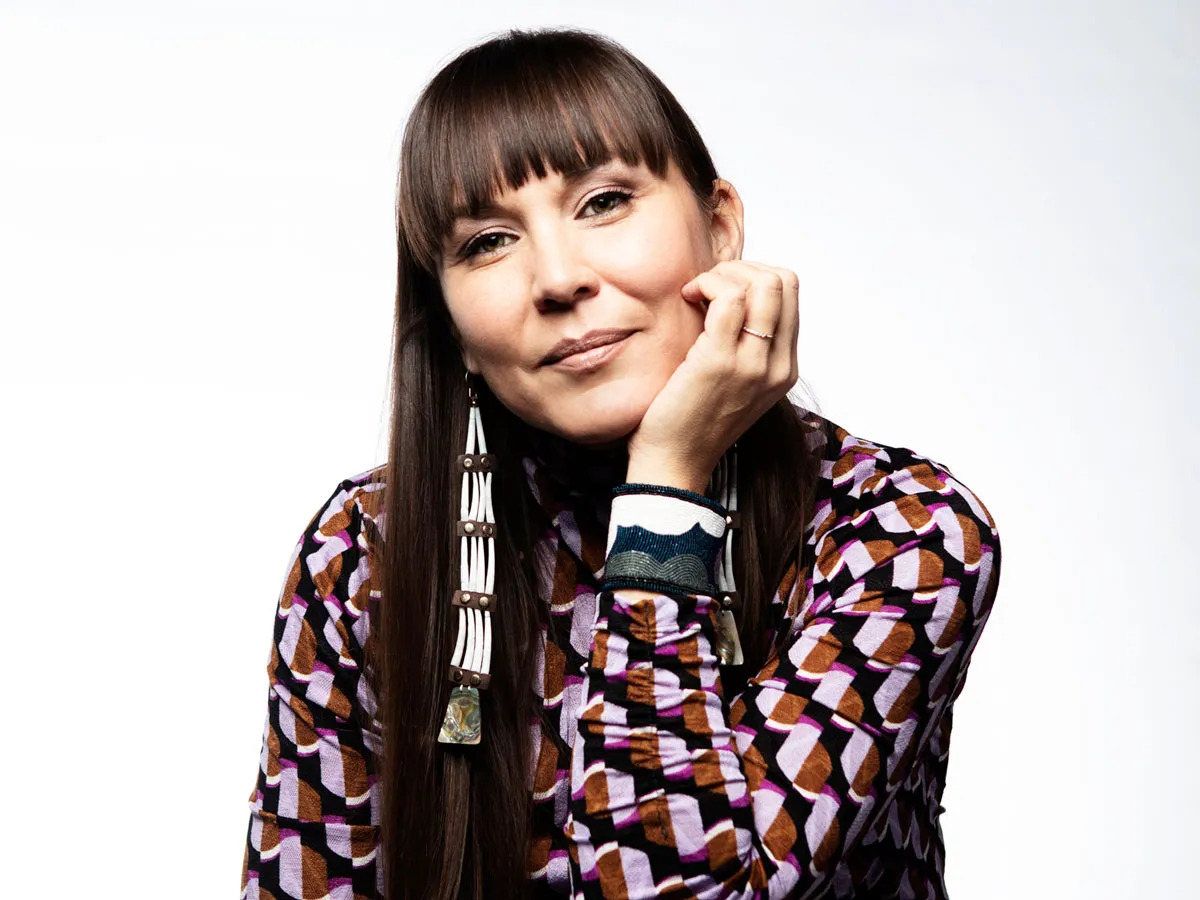
The photographs of Cara Romero operate on the precipice between the risk of death and possibility of self-dissolution. A woman buried in sand stares resolutely at the viewer, or a figure floats in a body of water below an oil field. Her lens fuses Indigenous ancestral memory with the immediacy of pop culture. Her world-building, indebted to centuries-old oral tradition, doesn’t merely picture survival; it renders it mythic, futuristic, and, crucially, still unfinished.
Defying the erasure of California Indian peoples, Romero, an enrolled citizen of the Chemehuevi Indian Tribe, sees her work as “painting with the light of photography,” as she told ARTnews during a recent interview. “We don’t have a word in our language for photography. The figures [in my work] represent ideas and stories bigger than themselves––and at the heart of my work is shared storytelling, representation, and collaboration with loved ones, friends, and family appearing in a kind of repertory.”
Romero is having the greatest exposure of her career to date, having featured in more than 10 museum group exhibitions since last fall, including “Smoke in Our Hair: Native Memory and Unsettled Time” at the Hudson River Museum (through August 31) and “Second Nature: Photography in the Age of the Anthropocene” at the Cantor Art Center (through August 3).
At Dartmouth’s Hood Museum in New Hampshire, she is the subject of her first institutional solo show, “Panûpünüwügai,” a Chemehuevi word that translates as both “source of light, like sun coming over the mountains” and “animating the inanimate, giving spirit, or living light.”
“The spirit of the light, or living light, references the painting of light with photography, bringing these stories to life and people together,” Romero said of the exhibition’s title. “These gifts photography has brought to my life.”
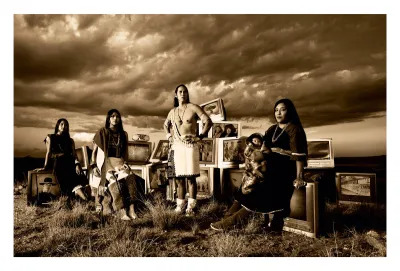
Romero’s wry, autochthonous lens cuts through the stereotypes of Native people, women in particular, placing them at the center of the American landscape. In TV Indians (2017), for example, a group of Indigenous people wearing historic garb are seen in a desert landscape, a mound of vintage televisions behind them. This pile of TVs refers to the ancestral adobe ruins scattered throughout the Southwest, and imbues them with a moribund quality, not onto the decidedly animate subjects, but instead upon the Hollywood caricatures, which flash on the screens behind them, that they are laying to rest.
In Romero’s images, an Indigenous futurist aesthetic emerges, as in 3 Sisters (2022), in which the titular figures are perched on a cloud against a purple celestial sky. Donning early-aughts rectangular sunglasses and Evoking it-girl goddesses, their bluish skin is tattooed from head to toe, in motifs specific to each sitter’s tribe (Anishanaabe, Pueblo, and Sioux, from left to right). They don early-aughts rectangular sunglasses, and wires carry life-giving energy from their bodies to the rest of the world. Romero’s 3 Sisters recalls depictions of nude women from across art history, while simultaneously upending the male and colonial gaze completely, reclaiming space—both literally and figuratively—for Native womanhood.
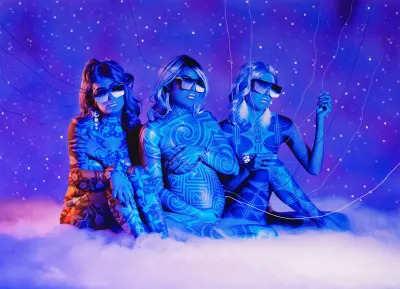
These Native women confront a world that seeks to dominate them, not as passive figures but as agents of deliberate refusal, according to curator Rebecca DiDimenico, who included Romero in a recent exhibition at the Boulder Museum of Contemporary Art in Colorado. She added, “Her work disrupts not only how Native bodies are represented in the art world, but where they are allowed to exist at all––refusing the boundaries that would confine Indigenous subjects to ethnographic display or historical past.”
Moments of levity abound through Romero’s saturated colors and campy pop iconography. Her “Imagining Indigenous Futures” series features subjects adorned in stripes and traditional tattoos, suspended in space with corn, or haloed and enrobed in raven feathers. By contrast, Arla Lucia (2019) layers markers of Indigeneity—dentalia, bead and quillwork earrings, a heraldic necklace—onto a portrait of Wonder Woman, exalting Native feminine power through materials and myth. (The photograph features in both her Hood Museum survey and “Indigenous Identities: Here, Now & Always,” curated by late artist Jaune Quick-to-See Smith at Rutgers’s Zimmerli Art Museum.)
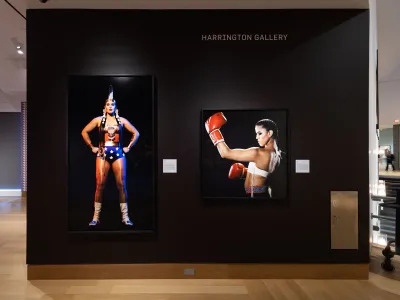
Her interest in infusing pop culture into her images, Romero said, had been a motivation since childhood “because of our absence—and complicated presence—in media. We were never in Life Magazine, never in art books, never in the anthropological canon except as objects. But I also admired the photography of dominant American pop culture. Now, I’m creating a narrative by placing us in different decades, responding to that absence with a quirky presence.”
She added, “I blend time to say: we have our own lived experiences woven into the fabric of America. We’re not all historic or bygone. We’re still here, living tremendous lives.”
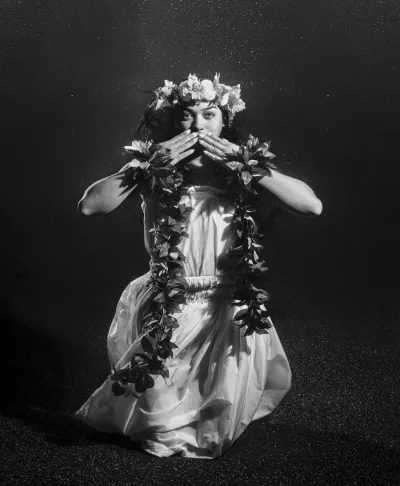
That insistent refrain of “We are still here” present across Romero’s oeuvre is best exemplified in works like Ha’ina’ia mai (2024), a black-and-white image in which a lei-draped Native Hawaiian woman rests on the seabed beneath the water’s surface, her hands extended in a submerged greeting, a gesture of welcome, survival, and futurity.
But Romero also turns her lens on issues of climate change, specifically from an Indigenous perspective, like in Evolvers (2019) where feather-crowned children sprint across hot sand in a desert sprinkled with wind turbines. In Weshoyot (2021), Weshoyot Alvitre, who is dressed in traditional Tongva garments, floats in a deluge, cleaving nets that try to catch her. Her apocalyptic compositions cut through the distant, desensitized haze of “climate porn” imagery that often accompanies these discussions, according to Eve Schillo, a photography curator at the Los Angeles County Museum of Art. At LACMA’s “Nature on Notice,” Romero’s Water Memory (2015) depicts two traditionally dressed Native figures in free-fall through water. Their descent is neither escape nor surrender, but an act of survivance in which memory of the past lives of the land are carried forth. The dammed rivers that submerged their homelands are remembered within the context of the climate crisis that now threatens all waters.
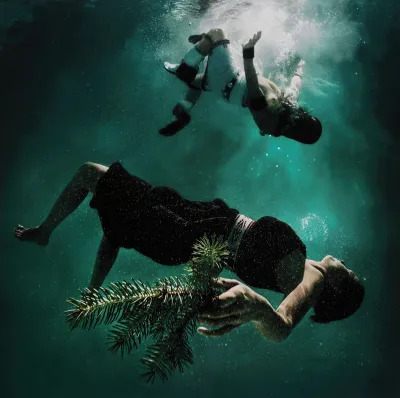
Entangled with the colonial gaze, Romero’s images don’t just disrupt the medium’s stereotypes but flip the structural frameworks that once sought to catalog, freeze, and erase Indigenous life altogether. In the 19th century, ethnographic photographers like Edward Curtis and Ansel Adams staged Native people in motley clothing borrowed from sundry other tribes, posing them in landscapes conspicuously cleared of settler presence to construct the fiction of a vanished race—all while obfuscating the violence that made such images possible.
“I call it the ‘one story narrative,’” Romero said of that 19th-century imagery. “There are thousands of different stories from our community, all totally valid.” This expansive vision feels particularly charged given Romero’s position as Chemehuevi, among California’s most systematically disappeared peoples and whose continued existence challenges the myth of a bygone people. Her pan-Indigenous casting becomes a kind of visual insurgency: Ohlone and Coast Miwok burial grounds, Native Hawaiian waters, Sioux beadwork traditions. It’s coalition building as aesthetic strategy, each collaboration a small act of resurrection against colonial archives that sought to fix Indigenous peoples in amber, forever in the past tense.
Romero continued, “When you can check internal biases about who Native people are—especially when it comes to photography harnessed by turn-of-the-century ethnographic photography—to be making contemporary work, it does a lot psychologically quite quickly. It says ‘Oh, these people are living,’ and ‘Oh, these people have a sense of humor,’ and ‘Oh, they have a shared sense of humanity that I can identify with.’ All those things are clever.”
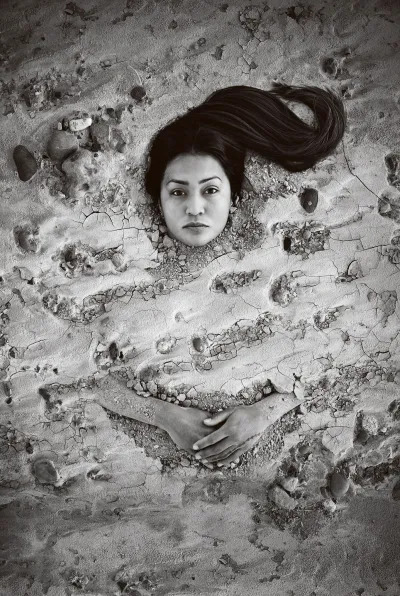
Humor is a core strategy Romero employs across various bodies of work. She draws viewers in with jocular visuals and cheeky titles, only to deliver a resonant and psychological gut punch. In Sand and Stone (2020), for example, a woman with long jet-black hair lays buried in the Mojave Desert, illustrating the creation story of the locale’s Southern Paiute people. The Mojave, like many desert landscapes, has become a psychic playground for non-Natives in search of reinvention or forms of transcendence. (Burning Man is held on Northern Paiute land.) Romero’s work doesn’t imagine a new Eden; it recalls the one that’s always been there, one that has repeatedly been buried under sand, stone, and spectacle. In thinking of the migration of recent disaffected settlers seeking spiritual redemption on stolen lands, an understanding of the bond between people and land becomes especially poignant.
“What interests [non-Native] people about our cultures tends to be the culturally private,” Romero said. “Yet we, without a choice, understand Western culture completely.” Even amid the asymmetry, she feels that she must “give generously and willingly,” offering viewers not just critique but communion.
Carlos Agredano Is Documenting the Harmful Effects of LA’s Pollution
Jordan Wolfson Makes Puppets of His Viewers with a New Work in Basel

This Sleek New 100-Foot Superyacht Is a Hard-Top Convertible for the High Seas

Skims Taps Roberto Cavalli for a Swim Collaboration That Oozes Retro Italian Glamour

July is going to be a huge month for Netflix documentaries

TNT Sports Is Parting Ways With NBA TV
